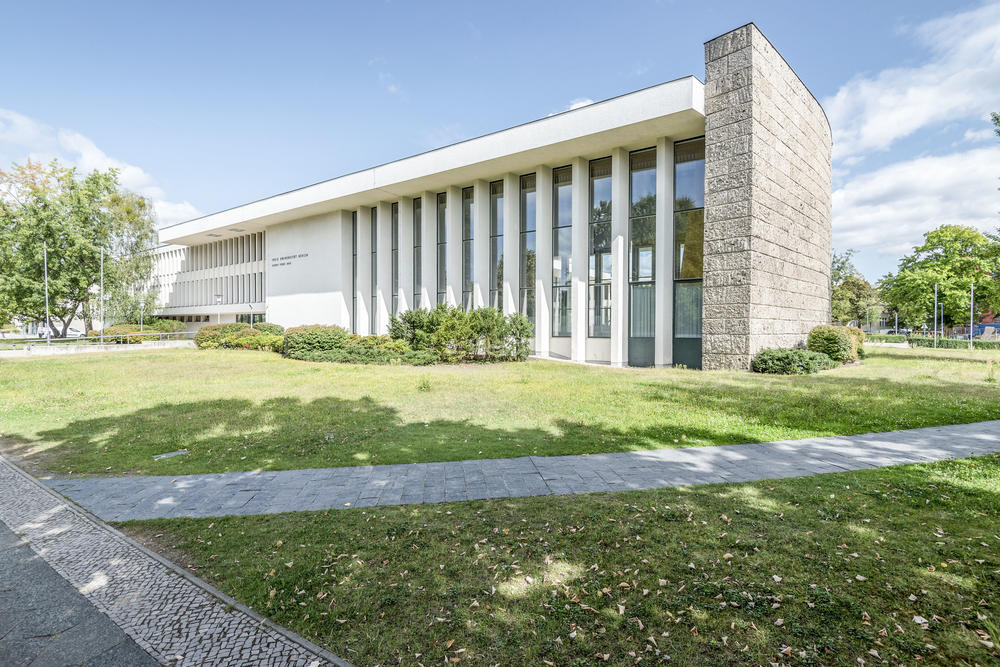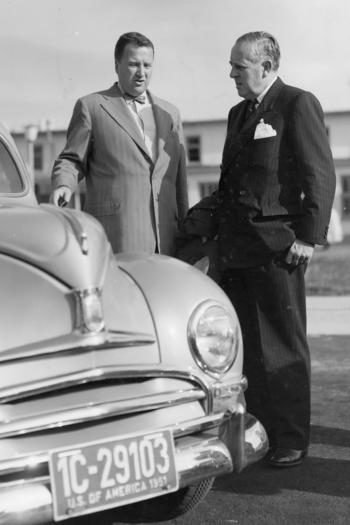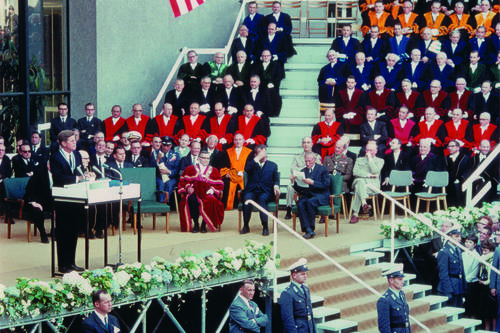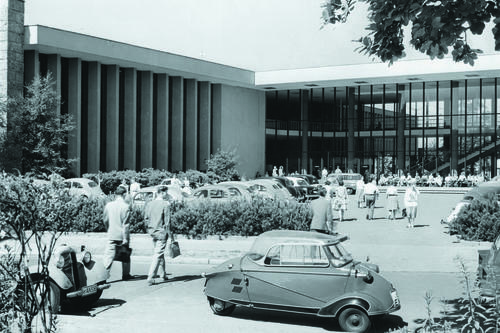How the Henry Ford Building Got Its Name
The history behind a major donation from the USA 66 years ago for the burgeoning Freie Universität Berlin
Mar 03, 2021
Flooded with light: The Henry Ford Building, connected by a bridge to the University Library, was designed by Franz Heinrich Sobotka and Gustav Müller and built from 1952 to 1954. It was the university’s second new building after the dining hall.
Image Credit: Bernd Wannenmacher
Numerous guests from Germany and abroad came to Berlin-Dahlem for the inauguration of the new lecture hall building of Freie Universität Berlin. On June 19, 1954, it was named Henry Ford Building.
The Governing Mayor of Berlin, Walther Schreiber, presented the keys to the Rector of Freie Universität, Ernst Eduard Hirsch, who gave the first speech. He was followed by the American High Commissioner James Bryant Conant; the German Federal Minister of the Interior, Gerhard Schröder; the Berlin Senator for Education, Youth, and Family, Joachim Tiburtius; the chair of the recently founded Ernst Reuter Association, Paul Hertz; and Klaus-Dietrich Gotthardt for the student council.
The 1500 guests included German Vice Chancellor Franz Blücher, the German Federal Minister of Economics Ludwig Erhard, numerous diplomats, members of the Bundestag (the German Parliament), and representatives from West German and foreign universities. The Ford Foundation contributed 7,402,660 German marks to the construction of the lecture hall building, attached library, and the new dining hall. Officials had agreed on the donation three years earlier, on June 9, 1951, when Henry Ford II visited Freie Universität.
In Berlin in June 1951: Henry Ford II and Paul G. Hoffman from the Ford Foundation discussed a substantial donation.
Image Credit: Photographer unknown
“Memorandum on the Free University of Berlin”
This agreement was preceded by a recommendation by the United States High Commissioner in Germany, John Jay McCloy, on January 15, 1951. McCloy sent his friend Paul G. Hoffman, who was the new president of the Ford Foundation, a “Memorandum on the Free University of Berlin” that had been written by Shepard Stone.
Shepard Stone, the son of Jewish immigrants from Lithuania, was a special advisor for public affairs and information to the American High Commissioner in Germany and was responsible for media, culture, and education. Paul G. Hoffman, in turn, until 1950, was responsible for implementing the Marshall Plan. John Jay McCloy suggested that the Ford Foundation should deal with the important free university project and encouraged Paul Hoffman to obtain first-hand information about the new university. Shepard Stone estimated the needed financial resources at 25 million German marks.
On April 26, 1951, the Germany expert from the State Department, Henry J. Kellermann, emphatically supported John Jay McCloy’s suggestion with a letter to Paul G. Hoffman. The Ministry of Foreign Affairs would very much like the foundation to decide to support the free university. Henry J. Kellermann was born in 1910 as the son of a Berlin rabbi. He earned his doctorate in law from Friedrich-Wilhelms-Universität in Berlin before emigrating to the United States in 1937. After the war, Henry J. Kellermann was one of the investigators in the American military service who gathered incriminating evidence for the Nuremberg trial of the main war criminals in 1945/46.
1,309,500 Dollars Were Granted
The efforts of John Jay McCloy, Shepard Stone, and Henry J. Kellemann fell on fertile ground. Henry Ford, Paul G. Hoffman, and the deputy president of the Ford Foundation, Robert Maynard Hutchins, traveled to Berlin to look into the development of Freie Universität. On June 9, 1951, they negotiated with the Governing Mayor of Berlin Ernst Reuter and the rector of Freie Universität, Freiherr von Kress, about the conditions for a potentially large donation. When asked by Paul G. Hoffman, Ernst Reuter guaranteed the long-term existence of the university and promised that in the event of German reunification “there will only be one university in Berlin, and that will be the Free University.” Only five weeks later, on July 16, 1951, Paul G. Hoffman telegraphed to Rector Baron von Kress that the Ford Foundation had “approved the Free University’s application for a donation of $1,309,500.”
In June 1963, U.S. President John F. Kennedy visited Berlin-Dahlem and urged Freie Universität to educate “citizens of the world.”
Image Credit: Landesbildstelle Berlin
Franz Leopold Neumann made the inital suggestion for naming the new lecture hall building. When Freie Universität was founded, Neumann campaigned tirelessly in the United States to promote the university and the implementation of political science as a subject at the university.
Franz Neumann, born on May 23, 1900, in Katowice, came from a Jewish family. He studied in Frankfurt am Main and, after completing his habilitation in law, taught at the trade union academy of labor. In 1927 he entered into a joint partnership with Ernst Fraenkel, who later became a professor at Freie Universität. At that time, both lawyers were on the teaching staff of the Deutsche Hochschule für Politik (DHfP, the German University of Political Science). After a brief arrest in 1933, Franz Leopold Neumann fled Germany. In the United States, as of 1936, he worked at the Institute for Social Research in New York, along with colleagues Theodor W. Adorno, Max Horkheimer, Herbert Marcuse, and other members of the Institut für Sozialforschung in Frankfurt am Main that had been dissolved by the Nazis.
Neumann‘s book Behemoth: The Structure and Practice of National Socialism, published in 1942, is still considered a standard work in Nazi research today. After World War II, Franz Neumann and Henry J. Kellermann belonged to the investigative group preparing the Nuremberg war crimes trial. After 1948 he taught at Columbia University in New York and wrote reports for the Ford Foundation on the development of Freie Universität, where he taught for a semester as a visiting professor. Neumann was instrumental in founding the Institute of Political Science, which in 1959 was integrated into Freie Universität as a research facility.
Franz Neumann’s suggestion for the naming is preserved in a document. On July 31, 1952, one year after the visit of the delegation consisting of Henry Ford II, the president of the Ford Foundation Paul G. Hoffman, and his deputy Robert Maynard Hutchins, the curator of Freie Universität, Fritz von Bergmann, wrote to inform the rector Professor Freiherr von Kress that Franz Neumann had raised the issue of “whether one should not name some of the lecture halls of the new building after personalities of the Ford Foundation, possibly the auditorium maximum as Henry Ford Hall and two others lecture halls after Mr. Hoffman and Mr. Hutchins.”
The Academic Senate Discussed Naming Various Lecture Halls
On March 3, 1954, the Academic Senate of Freie Universität dealt in its second item on the agenda with “naming lecture halls in the auditorium maximum after certain personalities” and decided to follow a proposal made by Rector Ernst Eduard Hirsch “that the building of the auditorium maximum should bear the name Henry Ford Building.” Hirsch had been in office as rector for eight months at the time.
A claim that has been widespread for a number of years that the building was named in honor of the anit-Semite Henry Ford I, who died in 1947, is untenable in light of the biography of the rector of Freie Universität. Ernst Eduard Hirsch, born in 1902 in Friedberg, Hesse, earned a doctorate and habilitation in law. In 1930 he was appointed a judge for life in Frankfurt am Main. On March 30, 1933, he was dismissed from the judiciary because of his Jewish origins. He then emigrated to Turkey. His sister Anni and other members of the family were murdered in Auschwitz.
Hirsch taught commercial law in Istanbul and Ankara and was one of the pioneers in reforming the Turkish legal system, which replaced Sharia law. He took on Turkish citizenship and intended to stay in Turkey.
In 1952 Ernst Reuter, with whom he had worked during emigration in Turkey, convinced him to accept a position at Freie Universität. Reuter persuaded Hirsch to participate in the training of a new generation of lawyers in Germany.
For several years, the space adjacent to the auditorium and the lobby was used as a parking lot. The vehicle in the foreground of this picture from the 1950s is a Messerschmitt cabin scooter.
Image Credit: Reinhard Friedrich
On June 11, 1954, Don K. Price, a vice president of the Ford Foundation, telegraphed H. Rowan Gaither, who was then president of the Ford Foundation, about a “surprise” being planned by Freie Universität for the inauguration of the new lecture hall building. The university planned to name the building “Ford Hall.”
They discussed whether Henry Ford should be consulted about this project. Ford’s friend Forrest Murden had advised them to let things take their course and not bother Henry Ford with the details. One day before the inauguration of the building, Forrest Murden, who had in the meantime been appointed Director for International Affairs of the Ford Foundation, telegraphed Shepard Stone (who had already arrived in Berlin) that Henry Ford had been informed about the planned naming and had been asked to telegraph Shepard immediately if he didn’t agree with these plans.
In his speech at the inauguration of the building, the rector expressly thanked Henry Ford II for his commitment. Henry Ford I was not mentioned, either in the two-hour ceremony or in the numerous press reports on the ceremony. In light of the fact that Shepard Stone received an honorary doctorate for his services and Paul Hertz was there representing the Ernst Reuter Association, it would have been a major affront that neither Shepard Stone nor Paul Hertz would have accepted. Both had Jewish origins, and both could be certain that Rector Hirsch would not have suggested an anti-Semite as the namesake of the new lecture hall building.
Shepard Stone had studied in Heidelberg and left Germany in 1933. Paul Hertz, as of 1922 a member of the Reichstag for the Social Democrats (USPD, and later the SPD), had experienced antisemitic agitation even before Hitler came to power. He was expatriated by the National Socialists in 1934 and did not return to Berlin from the United States until 1949.
In contrast to his grandfather, whom he disliked, Henry Ford II had a philosemitic attitude. After the state of Israel was founded, he supported Israel through a trade agreement and contributed 50,000 U.S. dollars to the first Christian donation campaign made by the United Jewish Appeal (UJA) for Israel. The Henry Ford Building of Freie Universität Berlin has a good name.
This text originally appeared in German on December 5, 2020, in the Tagesspiegel newspaper supplement published by Freie Universität.
Further Information
The author is on the staff of the University Documentation Center and a project leader in the Research Association on the SED State.




